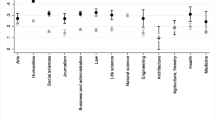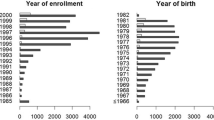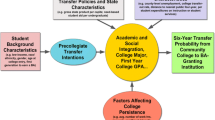Abstract
Growing accountability pressures, accompanied by a lack of readily accessible measures of institutional performance, have led to an increasing focus on graduation rates. Although previous research has illuminated myriad factors influencing students’ likelihood of educational success, it has not paid adequate attention to how state contexts may shape student outcomes. I build on the small but growing body of research exploring the role of state characteristics in facilitating student success in higher education. Controlling for a range of state and individual attributes, I examine how one aspect of the state context––the distribution of enrollments in 2 vs. 4-year public institutions––is related to bachelor’s degree attainment of students attending public 4-year colleges and universities. The results suggest that the larger the proportion of students attending community colleges in a state, the higher the probability of bachelor’s degree attainment at public 4-year institutions. This appears to be a product of student sorting: the presence of community colleges facilitates sorting of students into higher education in a way that is associated with higher degree completion at public 4-year institutions. These findings have important implications for research on student outcomes and policies aimed at evaluating the performance of public 4-year institutions.



Similar content being viewed by others
Notes
Different data sources produce similar six-year bachelor’s degree completion rates, which at public 4-year institutions are estimated at approximately 53% (The Chronicle of Higher Education 2008; see also NCES 2003a). Considering more traditional students and longer time frames produces higher graduation rates; yet even then, many students leave higher education without a degree in hand.
The results are not substantively altered if both enrollments and degrees are coded in the same year.
Alaska is the outlier in the bottom left portion of the graph. If removed, the correlation still remains strong and significant, r = 0.696, p < 0.05. Moreover, a strong positive correlation between the size of the community college sector and 4-year retention and graduation is reported in Measuring Up (author’s calculations). The correlations are slightly weaker in Measuring Up because their state estimates are based on aggregating institutional graduation rates which have more variability and because they include both public and private 4-year institutions.
I am not aware of any published work testing this hypothesis.
Author’s calculations based on data from California and Florida (both of which enroll a large proportion of public higher education students in community colleges) suggest that those states do not have notably higher transfer rates than the national average reported in the Transfer Assembly Project (see Cohen 1994,1996).
Using an alternative definition, one denoting a consolidated governing board without a distinction regarding 2 vs. 4-year institutions, does not substantively alter the reported results.
Although the authors do not provide coefficients and standard errors to statistically test these differences, the odds ratios for entry into 4-year and 2-year public institutions are virtually identical. Odds ratios for state appropriations are 1.047 for entry into public 2-year and 1.046 for entry into public 4-year institutions. Similarly, odds ratios for need-based financial aid are 1.188 for entry into public 2-year and 1.162 for entry into public 4-year institutions (Perna and Titus 2004; Table 1; similar patterns are reported in Table 3).
Coefficients for individual-level factors are as expected. However, it is important to keep in mind that the first set of coefficients (from female to expecting a bachelor’s degree) needs to be interpreted in combination with Table 1 because the sorting process was estimated with these individual-level characteristics in the model.
Part of the explanation for a lack of significant findings in Model 2 may be attributed to relatively large standard errors resulting from a reduced sample size. However, even if variables are entered one at the time or in blocks (e.g., financial context, articulation, governance, other controls), none of the state-level characteristics are statistically significant.
The most recent version of the Beginning Postsecondary Students (BPS) dataset includes representative samples of students in 12 states, highlighting the potential and challenges associated with collecting state representative samples.
In the meantime, careful studies of individual states over time can provide useful insights. However, individual state analyses cannot be generalized, as each state is characterized by a unique set of characteristics, necessitating the development of a national dataset including many if not all states.
References
Alfonso, M. (2006). The impact of community college attendance on baccalaureate attainment. Research in Higher Education, 47, 873–903.
Allison, P. D. (2002). Missing data. Thousand Oaks: Sage University Press.
Anderson, G. M., Sun, J. C., & Alfonso, M. (2006). Effectiveness of statewide articulation agreements on the probability of transfer: A preliminary policy analysis. Review of Higher Education, 29, 261–291.
Archibald, R. B., & Feldman, D. H. (2008). Graduation rates and accountability: Regressions versus production frontiers. Research in Higher Education, 49, 80–100.
Arum, R. (1996). Do private schools force public schools to compete? American Sociological Review, 61, 29–46.
Astin, A. W. (1993). College retention rates are often misleading. The Chronicle of Higher Education, September 22, A48.
Astin, A. W. (1997). How “good” is your institution’s retention rate? Research in Higher Education, 38, 647–658.
Berger, M. C., & Kostal, T. (2002). Financial resources, regulation, and enrollment in US public higher education. Economics of Education Review, 21, 101–110.
Brint, S., & Karabel, J. (1989). The diverted dream: Community colleges and the promise of educational opportunity in America, 1900–1985. New York: Oxford University Press.
Carey, K. (2004). A matter of degrees: Improving graduation rates in 4-year colleges and universities. Washington DC: The Education Trust.
Clark, B. R. (1960). The ‘cooling-out’ function in higher education. American Journal of Sociology, 65, 569–576.
Cohen, A. M. (1994). Analyzing community college transfer rates. In A. M. Cohen (Ed.), Relating curriculum and transfer. New directions for community colleges, No. 86 (pp. 71–79). San Francisco: Jossey-Bass Publishers.
Cohen, A. M. (1996). Orderly thinking about a chaotic system. In T. Rifkin (Ed.), Transfer and articulation: Improving policies to meet new needs. New directions for community colleges, No. 96 (pp. 25–34). San Francisco: Jossey-Bass Publishers.
Cohen, J., & Cohen, P. (1975). Applied multiple regression/correlation analysis for the behavioral sciences. Hillsdale, NJ: Lawrence Erlbaum Associates.
Dougherty, K. J. (1992). Community colleges and baccalaureate attainment. Journal of Higher Education, 63, 188–214.
Goenner, C. F., & Snaith, S. M. (2004). Accounting for model uncertainty in the prediction of university graduation rates. Research in Higher Education, 45, 25–41.
Hauptman, A. M. (2001). Reforming the ways in which states finances higher education. In D. E. Heller (Ed.), The states and public higher education policy (pp. 64–80). Baltimore: The John Hopkins University Press.
Hearn, J. C., Griswold, C. P., & Marine, G. M. (1996). Region, resources, and reason: A contextual analysis of state tuition and student aid policies. Research in Higher Education, 37, 241–278.
Heller, D. E. (1999). The effects of tuition and state financial aid on public college enrollment. Review of Higher Education, 23, 65–89.
Heller, D. E. (2006). Merit aid and college access. Symposium on the consequences of merit-based student aid. Wisconsin Center for the Advancement of Postsecondary Education, University of Wisconsin, Madison.
Kane, T. J. (1995). Rising public college tuition and college entry: How well do public subsidies promote access to college?. Cambridge, MA: National Bureau of Economic Research. NBER Working Paper No. 5164.
Kipp, S. M., I. I. I., Price, D. V., & Wohlford, J. K. (2002). Unequal opportunity: Disparities in college access among the 50 states. Indianapolis: Lumina Foundation for Education.
Leigh, D. E., & Gill, A. M. (2003). Do community colleges really divert students from earning bachelor’s degrees. Economics of Education Review, 22, 23–30.
McDonough, P. M. (1997). Choosing colleges: How social class and schools structure opportunity. Albany: State University of New York.
McGuinness, A. C., Jr. (1994). State postsecondary education structure handbook. Denver, CO: Education Commission of the States.
McLendon, M. K., Hearn, J. C., & Deaton, R. (2006). Called to account: Analyzing the origins and spread of state performance-accountability policies for higher education. Educational Evaluation and Policy Analysis, 28, 1–24.
Monk-Turner, E. (1995). Factors shaping the probability of community versus 4-year college entrance and acquisition of the B.A. degree. The Social Science Journal, 32, 255–264.
National Association of State Scholarship and Grant Programs. (1993). Annual survey report 1992–1993 academic year. Harrisburg, PA: Pennsylvania Higher Education Assistance Agency.
National Center for Education Statistics [NCES]. (1994). Digest of education statistics. Washington DC: U.S. Department of Education.
National Center for Education Statistics [NCES]. (2002). NELS 1988: Base-year to fourth follow-up date file user’s manual (NCES 2002–323). Washington DC: U.S. Department of Education.
National Center for Education Statistics [NCES]. (2003a). Descriptive summary of 1995–96 beginning postsecondary students: Six years later (NCES 2003–151). Washington DC: U.S. Department of Education.
National Center for Education Statistics [NCES]. (2003b). Postsecondary attainment, attendance, curriculum, and performance (NCES 2003–394). Washington DC: U.S. Department of Education.
National Center for Education Statistics [NCES]. (2007). Digest of education statistics. Washington DC: U.S. Department of Education.
National Center for Public Policy and Higher Education. (2002). Losing ground: A national status report on the affordability of American higher education. San Jose, CA: National Center for Public Policy and Higher Education.
Pascarella, E., & Terenzini, P. (2005). How college affects students: A third decade of research. San Francisco: Jossey-Bass.
Paulsen, M. B., & St. John, E. P. (2002). Social class and college costs: Examining the financial nexus between college choice and persistence. Journal of Higher Education, 73, 189–236.
Perna, L. W. (2006). Studying college access and choice: A proposed conceptual model. In J. C. Smart (Ed.), Higher education: Handbook of theory and research (Vol. 21, pp. 99–157). The Netherlands: Springer.
Perna, L. W., Rowan-Kenyon, H., Bell, A., Thomas, S. L., & Li, C. (2008). A typology of federal and state programs designed to promote college enrollment. Journal of Higher Education, 79, 243–267.
Perna, L. W., & Thomas, S. L. (2008). Theoretical perspectives on student success: Understanding the contributions of the disciplines. ASHE higher education report (Vol. 34). San Francisco: Jossey-Bass.
Perna, L. W., & Titus, M. A. (2004). Understanding differences in the choice of college attended: The role of state public policies. Review of Higher Education, 27, 501–525.
Quigley, J. M., & Rubinfeld, D. L. (1993). Public choices in public higher education. In C. T. Clotfelter & M. Rothschild (Eds.), Studies of supply and demand in higher education (pp. 243–283). Chicago: The University of Chicago Press.
Roksa, J. (2009). Building bridges for student success: Are higher education articulation policies effective? Teachers College Record, 111 (in press).
Roksa, J., & Keith, B. (2008). Credits, time, and attainment: Articulation policies and success after transfer. Educational Evaluation and Policy Analysis, 30, 236–254.
Rouse, C. E. (1995). Democratization or diversion? The effect of community colleges on educational attainment. Journal of Business and Economic Statistics, 13, 217–224.
Rouse, C. E. (1998). Do two-year colleges increase overall educational attainment? Evidence from the states. Journal of Policy Analysis and Management, 17, 595–620.
Scott, M., Bailey, T., & Kienzl, G. (2006). Relative success? Determinants of college graduation rates in public and private colleges in the U.S. Research in Higher Education, 47, 249–279.
St. John, E. P. (2003). Refinancing the college dream: Access, equal opportunity, and justice for taxpayers. Baltimore: The Johns Hopkins University Press.
St. John, E. P., Chung, C. G., Musoba, G. D., & Simmons, A. B. (2004a). Financial access: The impact of state finance strategies. In E. P. St. John (Ed.), Public policy and college access: Investigating the federal and state roles in equalizing postsecondary opportunity (pp. 131–152). New York: AMS Press Inc.
St. John, E. P., Musoba, G. D., & Chung, C. G. (2004b). Academic access: The impact of state education policies. In E. P. St. John (Ed.), Public policy and college access: Investigating the federal and state roles in equalizing postsecondary opportunity (pp. 131–152). New York: AMS Press Inc.
The Chronicle of Higher Education. (2008). The 2007–08 Almanac (Vol. 54). Washington DC: The Chronicle of Higher Education.
The Secretary of Education’s Commission on the Future of Higher Education. (2006). A test of leadership: Charting the future of U.S. higher education. Washington DC: U.S. Department of Education.
Thomas, S. L., & Heck, R. H. (2001). Analysis of large-scale secondary data in higher education research: Potential perils associated with complex sampling design. Research in Higher Education, 42, 517–540.
Titus, M. A. (2006). No college student left behind: The influence of financial aspects of a state’s higher education policy on college completion. Review of Higher Education, 29, 293–317.
U.S. Census Bureau. (1994). Statistical abstract of the U.S. Washington D.C.: U.S. Government Printing Office.
Volkwein, J. F., & Tandberg, D. A. (2008). Measuring up: Examining the connections among state structural characteristics, regulatory practices, and performance. Research in Higher Education, 49, 180–197.
Weerts, D. J., & Ronca, J. M. (2006). Examining differences in state support for higher education: A comparative study of state appropriations for research I universities. Journal of Higher Education, 77, 935–967.
Whitaker, D. G., & Pascarella, E. T. (1994). Two-year college attendance and socioeconomic attainment: Some additional evidence. Journal of Higher Education, 65, 194–210.
Author information
Authors and Affiliations
Corresponding author
Appendix
Appendix
Rights and permissions
About this article
Cite this article
Roksa, J. Bachelor’s Degree Completion Across State Contexts: Does the Distribution of Enrollments Make a Difference?. Res High Educ 51, 1–20 (2010). https://doi.org/10.1007/s11162-009-9146-7
Received:
Accepted:
Published:
Issue Date:
DOI: https://doi.org/10.1007/s11162-009-9146-7




